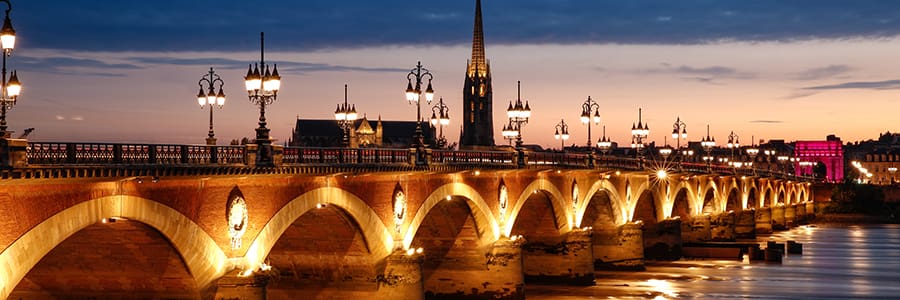
About The Garonne River
The name Garonne derives from Garumna, a Latinized version of the Aquitanian name meaning “stony river”.
Rising in the Spanish central Pyrenees and running through the Aquitaine Basin of southwestern France, the Garonne unites with the Dordogne 16 miles north of Bordeaux to form the vast Gironde Estuary. 374 miles in length, the Garonne forms part of the Canal des Deux Mers, linking the Mediterranean Sea and the Atlantic Ocean.
If you want to enjoy the very best of French culture and cuisine, forget Paris — Bordeaux is the city you want, and there is no finer way to get to know Bordeaux than from the decks of your very own cruise ship. In addition to seeing the city up close, you’ll venture in style along the water to view UNESCO-listed sites, visit world-famous vineyards, and soak up the gorgeous Aquitaine countryside.
The last time Queen Elizabeth visited Bordeaux, she called it “The very essence of elegance.” For the most elegant way to experience this most elegant of cities, do yourself a favor and let one of the many fine river cruise ships specializing in this region show you all its treasures.
Garonne River Stats
Length: 374 miles
Depth: Various
Source: Pyrenees, Spain
Mouth: Gironde Estuary into the Bay of Biscay, Atlantic Ocean, France
Locks: 53
Countries: Spain | France
Learn More About the Garonne River of Europe
The Garonne River, known as the Garona in Spanish, is a majestic and historically significant waterway that flows through France and Spain. It is one of the most prominent rivers in southwestern Europe, boasting a rich history, diverse ecosystems, and a profound cultural significance for the regions it traverses.
Geography and Source
The Garonne River originates in the Spanish Pyrenees, near the Col de Tentes in the Aragonese Pyrenees. Its source, known as the Garonne Glacier, feeds into the Val d’Aran in Catalonia, Spain. From this point, the river flows in a northwest direction before crossing into France.
Course and Tributaries
As the Garonne enters France, it continues its journey through the historic region of Gascony. The river’s course covers approximately 602 kilometers (374 miles) before it eventually empties into the Bay of Biscay in the Atlantic Ocean. Along its journey, the Garonne is joined by several major tributaries, including the Tarn, Lot, and Dordogne rivers, each contributing to the river’s volume and vitality.
Historical Significance
The Garonne River has played a pivotal role in the history and development of the regions it flows through. In ancient times, it served as a natural trade route, allowing for the transportation of goods between the interior of France and the Atlantic coast. The river was also crucial for the Roman Empire, facilitating communication and commerce. During the Middle Ages, the Garonne River was a strategic and often contested waterway, marked by the construction of numerous castles and fortifications along its banks. The city of Bordeaux, one of the largest cities in France, owes much of its historical and economic importance to its location along the Garonne River.
Ecology and Biodiversity
The Garonne River and its tributaries traverse a variety of landscapes, from rugged mountains in the Pyrenees to fertile plains in Gascony. This diversity of habitats has fostered a rich and varied ecosystem. The river and its floodplains are home to numerous species of fish, including salmon, trout, and shad. The surrounding wetlands provide critical breeding grounds for a wide range of bird species, making it an important area for birdwatchers and conservationists.
Economic Importance
The Garonne River has long been an essential resource for the regions it serves. Historically, it facilitated trade and commerce, allowing goods such as wine, grains, and timber to be transported to markets across Europe. In modern times, it continues to play a crucial role in the transportation of goods, with the port of Bordeaux serving as a major hub for both domestic and international trade.
Recreation and Tourism
The picturesque landscapes and cultural heritage along the Garonne River make it a popular destination for tourists and outdoor enthusiasts. The river offers opportunities for kayaking, canoeing, and fishing, while the scenic vineyards in the surrounding areas attract wine lovers from around the world. Additionally, the historic towns and cities along its banks, including Toulouse and Bordeaux, provide a wealth of cultural experiences for visitors.
Challenges and Conservation
Despite its historical and ecological significance, the Garonne River faces various challenges. Like many rivers worldwide, it is affected by pollution and habitat degradation, which threaten its biodiversity. Efforts are underway to address these issues, with organizations and governments working to improve water quality and protect critical habitats.
